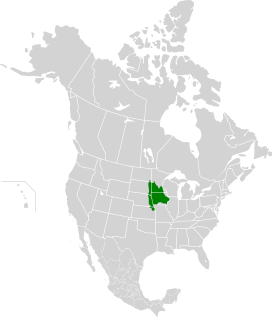Central tall grasslands facts for kids
Quick facts for kids Central tall grasslands |
|
|---|---|

Big bluestem, Andropogon gerardi
|
|
 |
|
| Ecology | |
| Realm | Nearctic |
| Biome | Temperate grasslands, savannas, and shrublands |
| Bird species | 228 |
| Mammal species | 67 |
| Geography | |
| Area | 248,400 km2 (95,900 sq mi) |
| Country | United States |
| States | North Dakota, South Dakota, Nebraska, Minnesota, Iowa, Missouri and Wisconsin |
| Conservation | |
| Habitat loss | 95.7% |
| Protected | 0.95% |
The Central tall grasslands are a special kind of prairie land in the Midwestern part of the United States. This area is a big part of the North American Great Plains. It's known for its very tall grasses.
Contents
Where Are the Central Tall Grasslands?
This amazing natural area covers a big part of southern Minnesota. It also includes most of Iowa. You can find it in a thin strip from southeastern North Dakota through eastern South Dakota and eastern Nebraska. It stretches all the way to northeastern Kansas.
What Makes This Area Special?
The Central tall grasslands get a lot of rain each year. About 1,000 millimeters (or 39 inches) of rain falls here. This is more rain than most other parts of the Great Plains. Because of this extra rain, the plants here can grow very tall and strong.
To the north, you'll find the Northern tall grasslands. They have different types of grass and fewer species. To the south, the Flint Hills tall grasslands have more rocks in their landscape.
Plants of the Tall Grasslands
The Central tall grasslands once had the largest area of tallgrass prairie in the world. The high rainfall and long summers helped plants grow very well. Some grasses could reach up to 2 meters (or 6.6 feet) high! Many colorful wildflowers also grew among the grasses.
For example, scientists found 265 different kinds of plants in Iowa. Near Lincoln, Nebraska, 237 species were found in just one square mile. In the Missouri River Valley, 225 plant species were recorded.
Why Are They Different Now?
The soil in this area is very rich and good for growing crops. Because of this, most of the original grasslands have been turned into farms. This has happened much more here than in nearby areas like the Flint Hills. Today, the Central tall grasslands are a big part of the Corn Belt in the Midwest. You will mostly see fields of corn and soybeans instead of wild grasses.
What Grasses Grow Here?
Even with all the farms, some important grasses still grow in this region. These include:
- Big bluestem (Andropogon gerardi)
- Switchgrass (Panicum virgatum)
- Indian grass (Sorghastrum nutans)
Animals of the Tall Grasslands
Long ago, this prairie was likely home to many large grazing animals. These included the American bison (Bison bison). You might also have seen elk (Cervus elaphus) roaming freely.
Protecting the Grasslands
Sadly, almost all of the original Central tall grasslands are gone. Only small pieces remain scattered around. However, people are working hard to bring these prairies back. This effort is called prairie restoration.
For example, at the Neal Smith National Wildlife Refuge in Jasper County, Iowa, they are restoring the prairie. They are planting native grasses and wildflowers again. This helps bring back the natural habitat for animals and plants.

